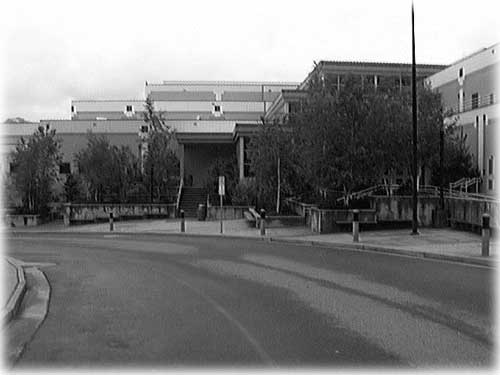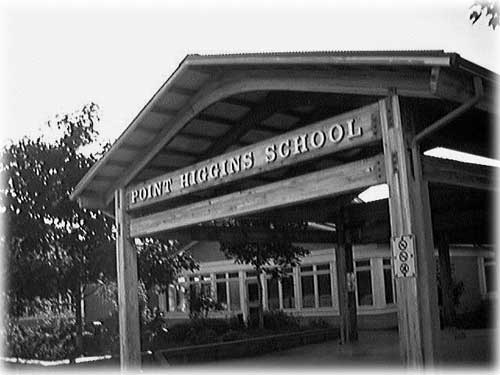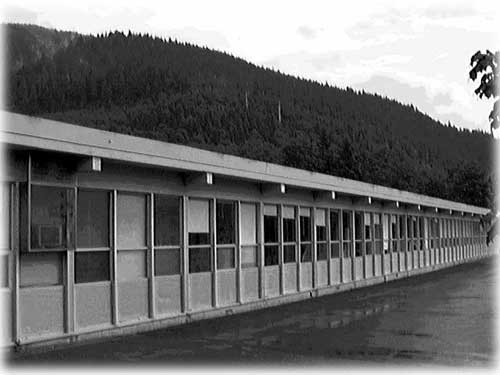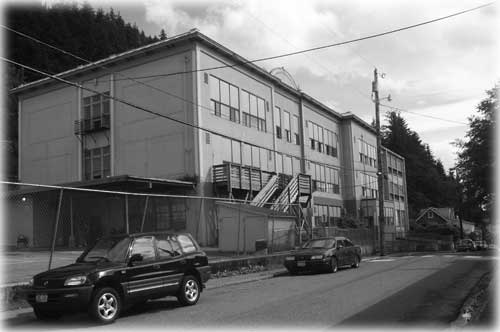 Readin' and writin' and 'rithmetic again By June Allen September 01, 2003
 The hilltop Main School building built in 1904 is visible in this photograph. Its façade and cupola was a landmark for the next twenty years. The exterior was impressive, with dormers, a bell tower and a magnificent double stairway leading to the school's second floor entrance from both the Edmond Street stairway and the Grant Street stairway. Forms part of: Frank and Frances Carpenter collection (Library of Congress). Gift; Mrs. W. Chapin Huntington; 1951. Courtesy Library of Congress
There was at the turn of the 20th century an Episcopal mission school for Indian children, on Mission Street, next to today's dime store site. It was taught by missionary Agnes Edmond, who in 1898 arrived as Ketchikan's first unmarried white woman. And from 1901 to 1904 when it was destroyed by fire there was a school for the Indian children at Port Gravina, a Tsimshian sawmill town that was located on the site of today's Ketchikan International Airport. It was first taught by Miss Bertha Hunt.  Photograph by Dick Kauffman
In a 1965 interview, Amy Hunt Craft remembered that one-room school. She said it was in the building occupied by the local TV station KATV, which then, in 1965, was located in the building which is still today located between the rear of the city police station and the old Elks/Fireside building now housing the Senior Services office. Some of her schoolmates, she said, were Sterling and Glen Garret, Lawrence and Clara Diaz, Irene Chesney, and Elmer, Frances and Marge Grant. The teacher was Mrs. Anna Hicks of Tacoma, who husband Dr. Hicks was a dentist. The couple came to Ketchikan at the request of the Forest J. Hunt, an old friend, and stayed to help until 1908. The following year, bids were let for a new school building to be built almost directly across Main Street from that first classroom. Contractor Canfield & Cornell's bid of $1,377.50 [in today's dollars that would be about $31,450] was accepted and work began. Chris Hoover received an additional $180 to paint the building plus a small additional charge for painting the cupola and porch as well as the water closet (toilet) and coal shed at the rear of the building. Laura Mae Willis, later to become Mrs. M.S. Dobbs, taught all the grades in the building, assisted by Mrs. Hicks, Miss Elizabeth Heckman and Miss Margie Henry. At that time, Main "Street" up from Dock Street was a muddy gully of berry bushes and boulders. Two narrow plank foot bridges were built across it so the children could get from one side to the other. The following year the permanent planking of the street got under way.  photograph by Dick Kauffman
Taking into account Ketchikan's rainy weather, the ground floor of the spacious new school had two large playrooms. If the climb up the hills and stairway street to get to school didn't burn off excess energy, the playrooms would. The second floor was divided into a large multi-purpose hall with three classrooms, one of them a library. The second room was for grades one, two and three, and the third room for grades four, five and six. The third floor housed the seventh and eighth grades and the high school students. The principal was Professor Bertram Mitchell. A Miss Harrington taught the primary grades and a Miss Karesek taught the intermediate grades, with the professor in charge of the upper classes. The cost for the new schoolhouse in 1904 was $10,000, a sizable amount at the time. [In today's dollars it would total $249,320.]  photograph by Dick Kauffman
And school went on as usual. Ketchikan's city fathers sold the little schoolhouse on Main Street to the Catholic Church in 1907. The sturdy building and its cupola was remodeled easily into a new Holy Name Church. When a new replacement church was built on the West End, the downtown schoolhouse/church - cupola removed - became a number of businesses. At one time it was Dr. Babcock's offices. At a later time it was the Iron World Gym. Finally, the city council tore the historic old building down to make way for a parking lot. At first, the wreckers were told to save any likely artifact the demolition might reveal. But time was pressing and the effort was abandoned.  photograph by Dick Kauffman During the World War I years, 1917-18, the teachers at the hilltop Main School were Professor and Mrs. Knox, Miss May Barlow, Miss Inabel Hawk, and Miss Harriet Rossiter. (Note that female teachers had to be single, and if they married, they had to give up teaching; that requirement lasted until the 1940s, during World War II.) Miss Rossiter distinguished herself during the 1918 Spanish Influenza epidemic. The disease hit hard worldwide and Ketchikan was no exception. Movie houses closed as did any place where people congregated. Schools closed temporarily. Most people were afraid to go anywhere near those ill with the dreaded disease. But Miss Lassiter nursed the isolated flu patients in a temporary hospital set up in the basement of the Methodist Church on Main Street, earning the town's gratitude. The town had its questionable educational moments when it declined to educate the many immigrant Norwegian children, some of whom spoke little or no English but who contributed so hugely to the town's survival in the austere times and its successes in the prosperous times. How amusing is it that those children were schooled in an abandoned, ramshackle roadhouse that had been closed when Prohibition went into effect, the learning financed by the federal government. Not surprisingly, however, the children loved their offbeat school and were fiercely loyal to it. They were later moved in the educational mainstream - and buildings - with their peers. In general, Ketchikan's schooling picture stayed in step with the march of time. The elegant but soon-old-fashioned Grant street hill school was torn down and replaced in 1925 with a much larger and much safer concrete building with a sleek but modified art deco touch. Even that was not large enough to handle all of the educational needs in town. White Cliff School would be the first to be built, in 1927, to handle the growing overflow of younger children. There would be other new schools as the years passed and there would be parochial and eventually alternative and charter schools on the scene. And there will always remain the memories of those school days, whatever the era. The teachers. The games. The spelling tests and Christmas pageants and plays. The PTA meetings and the teacher conferences and dress codes and the principal's dreaded office. The band concerts with youthful cheeks bulging and little lungs gasping for air as the determined young musicians soldiered on. The school plays with all the giggles and flubs. The romances and flirtations and lettuce from school lunches caught in braces. Memories of Miss Hyde, Mrs. Myser, Mrs. Munch with the classy old Chevy, and Mr. Wipfli in a snit, and all the others. There's that reality to factor into the educational picture. And now it's repeating itself all over again. Like it did when we were kids. Did we ever really chant, "No more pencils, no more books, No more teachers' dirty looks!"
june@sitnews.org
All rights reserved. Not to be reprinted in any form without the written permission of June Allen.
|
|||||||




